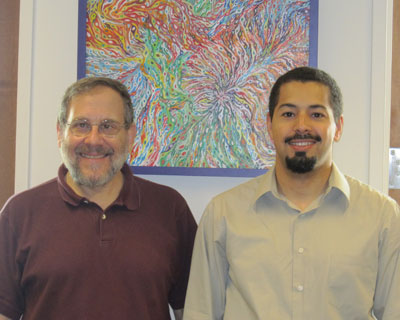(L to right) Gregorio Valdez and Joshua R. Sanes
The great baseball player, Lou Gehrig, gave his name to the neurodegenerative disease that killed him, Amyotrophic Lateral Sclerosis. Greg Valdez and Joshua Sanes in MCB, along with Andrew Williams and Eric Olson at University of Texas, showed that a microRNA plays a role in the pathogenesis of this disease. (Science, December 11, 2009)
Amyotrophic lateral sclerosis, abbreviated ALS and commonly known as Lou Gehrig’s disease, is a neurodegenerative disorder of motor neurons, the cells that receive commands from the brain and transmit them to muscles at neuromuscular synapses, thereby controlling all voluntary movement. When the motor neurons die, they leave the muscle fibers without input, leading to paralysis and eventual respiratory failure. The disease is invariably fatal and there is neither a cure nor even an effective treatment.
An interesting feature of the disease is that it is generally asymptomatic until a large fraction of the motor neurons have already died. What happens is that the remaining motor neurons “sprout” to innervate the muscle fibers vacated by their deceased brethren. Somehow the denervated muscle fibers sense their lossand send a signal to nearby motor axons, triggering them to form new synapses. Clearly, this compensatory response is inadequate, but it is important to understand how it works, since one can imagine that it could be enhanced to postpone or even prevent disease progression.
In the December 11, 2009 issue of Science, Greg Valdez and Joshua Sanes in MCB teamed up with Andrew Williams and Eric Olson at the University of Texas to demonstrate a role for microRNAs (miRNAs) in this process. Knowing that miRNAs often regulate stress responses, they asked whether levels of any particular miRNAs increased in a mouse model of ALS. They found that denervation of muscle leads to a dramatic induction of miRNA-206. They then generated and characterized targeted mutants of the miRNA-206 gene, and crossed them to the ALS mice. They found that loss of miRNA-206 had little effect on development of muscle or neuromuscular synapses, but speeded disease progression by slowing the ability of axons to form new synapses on denervated muscle fibers. Going further, they showed that miRNA-206 normally coordinates the muscle’s response to denervation, in part by increasing the efficacy of signals that the muscle sends back to the nerve. Remarkably, the signals include a set of fibroblast growth factors that Sanes and colleagues had previous shown to be muscle-derived promoters of neuromuscular synapse formation in normal embryos (Umemori et al., Cell, 2004; Fox et al., Cell, 2007). Thus, miRNA-206 appears to be part of a mechanism that allows the muscle to reawaken an embryonic program and attract new innervation in time of trouble. They are now eager to explore whether this pathway can be augmented to provide hope for victims of ALS.
Read more in Science
The cover that could have been.


